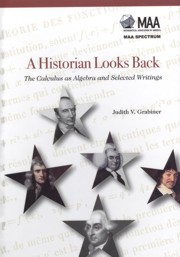Book contents
- Frontmatter
- Contents
- Introduction
- Part I The Calculus as Algebra
- Part II Selected Writings
- 1 The Mathematician, the Historian, and the History of Mathematics
- 2 Who Gave You the Epsilon? Cauchy and the Origins of Rigorous Calculus
- 3 The Changing Concept of Change: The Derivative from Fermat to Weierstrass
- 4 The Centrality of Mathematics in the History of Western Thought
- 5 Descartes and Problem-Solving
- 6 The Calculus as Algebra, the Calculus as Geometry: Lagrange, Maclaurin, and Their Legacy
- 7 Was Newton's Calculus a Dead End? The Continental Influence of Maclaurin's Treatise of Fluxions
- 8 Newton, Maclaurin, and the Authority of Mathematics
- 9 Why Should Historical Truth Matter to Mathematicians? Dispelling Myths while Promoting Maths
- 10 Why Did Lagrange “Prove” the Parallel Postulate?
- Index
- About the Author
1 - The Mathematician, the Historian, and the History of Mathematics
from Part II - Selected Writings
- Frontmatter
- Contents
- Introduction
- Part I The Calculus as Algebra
- Part II Selected Writings
- 1 The Mathematician, the Historian, and the History of Mathematics
- 2 Who Gave You the Epsilon? Cauchy and the Origins of Rigorous Calculus
- 3 The Changing Concept of Change: The Derivative from Fermat to Weierstrass
- 4 The Centrality of Mathematics in the History of Western Thought
- 5 Descartes and Problem-Solving
- 6 The Calculus as Algebra, the Calculus as Geometry: Lagrange, Maclaurin, and Their Legacy
- 7 Was Newton's Calculus a Dead End? The Continental Influence of Maclaurin's Treatise of Fluxions
- 8 Newton, Maclaurin, and the Authority of Mathematics
- 9 Why Should Historical Truth Matter to Mathematicians? Dispelling Myths while Promoting Maths
- 10 Why Did Lagrange “Prove” the Parallel Postulate?
- Index
- About the Author
Summary
The historian's basic questions, whether he is a historian of mathematics or of political institutions, are: what was the past like? and how did the present come to be? The second question—how did the present come to be?—is the central one in the history of mathematics, whether done by historian or mathematician. But the historian's view of both past and present is quite different from that of the mathematician. The historian is interested in the past in its full richness, and sees any present fact as conditioned by a complex chain of causes in an almost unlimited past. The mathematician instead is oriented toward the present, and toward past mathematics chiefly insofar as it led to important present mathematics.
What questions do mathematicians generally ask about the history of mathematics? “When was this concept first defined, and what problems led to its definition?” “Who first proved this theorem, and how did he do it?” “Is the proof correct by modern standards?” The mathematician begins with mathematics that is important now, and looks backwards for its antecedents. To a mathematician, all mathematics is contemporary; as Littlewood put it [A7, p. 81], the ancient Greeks were “Fellows of another College.” True and significant mathematics is true and significant, whenever it may have been done.
The history of mathematics as written by mathematicians tends to be technical, to focus on the content of specific papers. It is written on a high mathematical level, and deals with significant mathematics. The title of E. T. Bell's The Development of Mathematics reflects the mathematician's view.
Information
- Type
- Chapter
- Information
- A Historian Looks BackThe Calculus as Algebra and Selected Writings, pp. 127 - 134Publisher: Mathematical Association of AmericaPrint publication year: 2010
